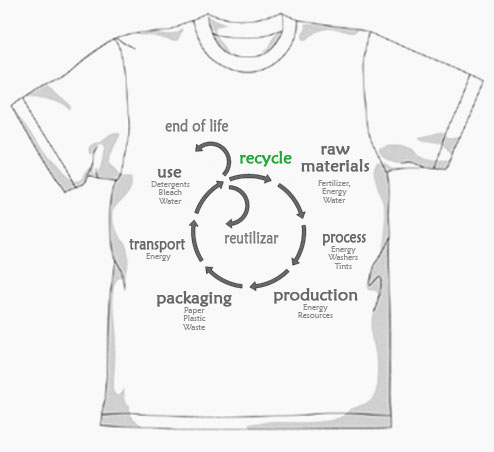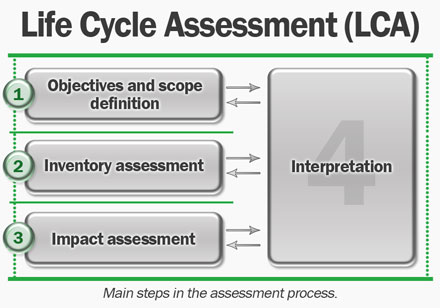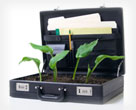Environmental analysis
|
The environment must be taken into account as another factor needed for the development of a project. In the case of products design, a product that doesn't consider the environmental factor in this phase, cannot be consider as a quality product. The environmental analysis contributes to know the environmental consequences that could have the project since it first stages. Therefore, you are able to take measures that eliminate, minimize or compensate the adverse impacts. Tools of environmental analysisThere are several tools that can be used for the realization of an environmental analysis. The use of one or another depends on the typology of the project and on the depth wanted. MIPS: Material Input per Service UnitIt quantifies the consumption of materials and energy needed (For example for obtaining a good product), divided by the unit of borrowed service. It is expressed in kg/kg or t/t. The entrances (input) of material and energy are contained in five categories:
At the same time, is applied to each input a conversion factor by category to convert it to ton or kg. 
More information about MIPS. Accumulated Energy demand (DAE) / Cumulative Energy demand (CED)Similar to the MIPS, this system quantifies only the consumption of energy needed for obtaining a good (for example a product) referred to an unit of borrowed service. It is expressed in MJ/kg. Ecological footprintsIt represents the quantity of territory needed to provide the consumed resources (direct or indirectly) for a person, group, product or activity. This is a tool that analyzes mainly the way of life, but although you can apply it to the products development. There are several calculators of ‘Ecological footprints’. They shows how many hectares are needed to maintain the rhythm of life of a person and how many planets would be needed if all the inhabitants of the earth lived as the same rhythm. Evaluation of design change (ECD)It analyses in a high-priority way the generation of residuals associated to the different stages of the cycle of life of a product. Their general target is to improve the products with the objective of reducing the quantity of residuals and its toxicity. The environmental strategy valuation (VAE) - LiDS WheelIt locates in a 'Spider’s cloth' type diagram the strategies of environmental improvement. In a proportional way, the degree of environmental improvement of each strategy is evaluated, comparing two products, in general a current product against a new one. Ecodesign ChecklistIt is based on questioning the product from the environmental perspective to discover weaknesses. It is a qualitative tool. MET analysisIt shows the environmental impacts in matrix form (materials and energy consumption and toxic emissions) associated to each phases of the cycle of life of the product. A main basic MET has the following aspect:
For more information: Manual of Ecodiseño of Ihobe, 2000. Análisis of cycle of life (ACV)For more information "Análisis of cycle of life". Análisis of simplified cycle of life (ACVS)For more information "Análisis of simplified cycle of life". Life Cycle ConceptA life Cycle of a product can begin with the extraction of the raw matters and the energy generation. The materials and the energy are transformed by the productive processes, becoming into a final product that it is transported and used. Finally the product arrives to its end of life and it can be recycled, reused or discard as waste. The cycle of life of the product allows us to analyze the environmental yield in all its stages, identifying the phases of intensive impact and helping to the obtaining of a consumption and more sustainable production. 
T-shirt cycle of live. Purchasing power: Harnessing Institutional Procurement for people and the planet, Julio 2003, Worldwatch Institute. Life Cycle AssessmentLife Cycle Assessment is a term created by the environmental appraisers to quantify the environmental impact of a material or product since it is extracted of the nature until it returns to the atmosphere like waste. In this systemic process natural resources are consumed and waste are emitted. The LCA is a technique to determine the environmental aspects and potential impacts associated to a product: compiling an inventory of the entrances and excellent exits of the system; evaluating the environmental potentials impacts, and interpreting the results of the inventory and impact phases in connection with the objectives of the study (According to ISO 14040:1997) The final goal of the LCA is to get a reduction of the material and energy consumptions and the emissions to the environment, applying the ideas of improvement that arise in the evaluation and interpretation of the analysis. The assessment is divided in four main stages: 
There is also a simplified Life Cycle Assessment (SLCA). It consist on the application of the LCA methodology to arrive to an approximate evaluation, to identify the high-priority aspects that it covers the whole Life Cycle but in superficial way, continued by a simplified evaluation of impacts. Tools for the Life Cycle AssessmentIn the market they can be several software tools for Life Cycle Assessment. These are some examples:
|
||||||||||||||||||||||||||||
Noticias
- Orange, Ricoh y Dídac Lee se llevan los Premios Excelencia 2015
- El empleo, la energía y el clima ejes del congreso de entidades locales CONAMA Local 2015
- El Gobierno Vasco subvenciona con 94 mil euros acciones que fomenten la movilidad activa en la población escolar
- La gestión de Residuos de Equipos Eléctrico Electrónicos (RAEE) en España sigue mejorando gracias a la Fundación Ecolec
Environmental services
Our company offers environmental engineering solutions, ecodesign and all type of projects for the sustainable development of the companies.

Sustainable development
"To satisfy the necessities of the present without committing the capacity of the future generations to satisfy their own necessities".

With this definition we offer our consultantship services in sustainable development.
Contact
Contact address:
c/ Beheko Kale nº13 Bajo
CP 01.170 Legutio (Álava)
Tel: 945 455905
Fax: 945 455930
ecolan@ecolaningenieria.com

